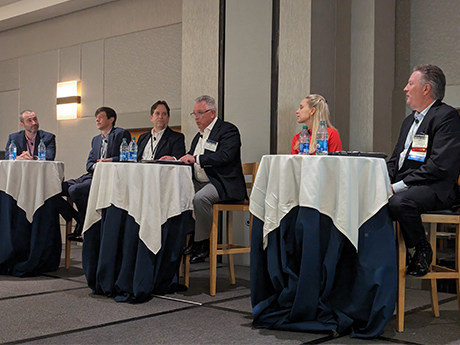ATLANTA — Investors in the multifamily sector are having trouble getting deals done in 2023, and 2024 isn’t looking to start out much better. The culprit is the bid-ask spread — the gap between what sellers believe their property is worth and what buyers are willing to pay.
That’s according to a panel of multifamily investors, several of whom described transacting in the present environment to be a “slog.”
The panel, titled “Investment Outlook: When will the Bid-Ask Gap Narrow, the Market Stabilize and Transactions Resume in Earnest?,” was held yesterday at France Media’s InterFace Multifamily Southeast conference at the Westin Buckhead in Atlanta.
The panel included Brian Grant, senior vice president of acquisitions of Equity Residential; John Leonard, first vice president/regional manager of Marcus & Millichap; Eddy O’Brien, managing partner and co-founder of Blaze Capital Partners; Matt Trammell, chief financial officer of Wood Partners; Kristina Lynn, senior director, of housing and alternative investments in the Americas at Nuveen Real Estate; and moderator Paul Berry, president and chief operating officer of Mesa Capital Partners, who recently joined the firm from CBRE.
Berry kicked off the discussion by noting that “the bid-ask spread affects all of us.” While he noted that transaction volume was particularly feverish in 2021 and early 2022, a variety of factors — most notably rising interest rates — have slowed everything to a crawl.
“Compared to even what we considered pre-COVID normal, it’s way down,” said Berry. “It’s not that people don’t want to own multifamily properties, it’s that the math is challenging.”
Grant said that Equity Residential was back buying again, but that in 2022 the firm “didn’t buy anything.”
“In 2022, the premium to replacement cost was so high we put our pencils down. How much would we buy if the bid-spread weren’t as wide? As much as we could.”
Trammell notes that despite the bid-ask gap, this is still a good time to be a seller.
“We’ve still been able to capture buyers because there’s so little product on the market,” said Trammell. “We benefitted greatly in 2021. From supply and demand, we’ve been able to get very aggressive offers.”
In fact, with an eye on a future with lower interest rates, many buyers are willing to live with negative leverage (buying properties where the interest rate on the acquisition loan is higher than the capitalization rate on the purchase). Those buyers will eventually refinance, even if it means living with that negative leverage for three to four years.
“If you don’t want negative leverage, you’re not going to transact in this market,” said Leonard.
“[Buyers are] banking on rates going down and they’re going to refinance in two years,” added Lynn.
The investors were non-committal regarding whether the industry had reached the bottom of the market cycle yet, but the consensus was that we’re close.
“I don’t know if we’re at the bottom,” said O’Brien. “Directionally, though, we’re around that base. I can say that with more confidence than last year. As people look at valuations, long-term fundamentals for housing across the country are great. With interest rates, let’s assume there’s some clarity there [in the near future].”
As for when multifamily investment will reach the peak prices of 2021, the investors said it will take a few more years.
“Some of those prices [in 2021] were pretty aggressive,” said Lynn. “It will probably take three to four years, but we will get there.”
— Jeff Shaw


